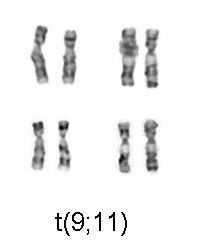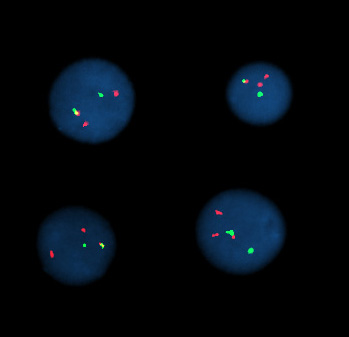Cytogenetics




|
WikiDoc Resources for Cytogenetics |
|
Articles |
|---|
|
Most recent articles on Cytogenetics Most cited articles on Cytogenetics |
|
Media |
|
Powerpoint slides on Cytogenetics |
|
Evidence Based Medicine |
|
Clinical Trials |
|
Ongoing Trials on Cytogenetics at Clinical Trials.gov Clinical Trials on Cytogenetics at Google
|
|
Guidelines / Policies / Govt |
|
US National Guidelines Clearinghouse on Cytogenetics
|
|
Books |
|
News |
|
Commentary |
|
Definitions |
|
Patient Resources / Community |
|
Patient resources on Cytogenetics Discussion groups on Cytogenetics Patient Handouts on Cytogenetics Directions to Hospitals Treating Cytogenetics Risk calculators and risk factors for Cytogenetics
|
|
Healthcare Provider Resources |
|
Causes & Risk Factors for Cytogenetics |
|
Continuing Medical Education (CME) |
|
International |
|
|
|
Business |
|
Experimental / Informatics |
Overview
Cytogenetics is the study of the structure of chromosome material. It includes routine analysis of G-Banded chromosomes, other cytogenetic banding techniques, as well as molecular cytogenetics such as fluorescent in situ hybridization (FISH) and comparative genomic hybridization (CGH).
History
Early years
Barbara McClintock began her career as a maize cytogeneticist. In 1931 McClintock and Harriet Creighton demonstrated that cytological recombination of marked chromosomes correlated with recombination of genetic traits (genes). McClintock continued her career in cytogenetics studying the mechanics and inheritance of broken and ring (circular) chromosomes of maize. During her cytogenetic work, McClintock discovered transposons, a find which eventually led to her Nobel Prize in 1983.
Modern cytogenetics is generally said to have begun in 1956 with the discovery that normal human cells contain 46 chromosomes by Tjio and Levan[1]. This discovery was aided by a new technique of slide preparation utilizing a hypotonic solution discovered by TC Hsu in 1952. A hypotonic solution is a salt solution less concentrated than that inside human cells, when added to a cell solution this causes the cells to swell. When the cells are added to the slide after treatment with hypotonic solution the chromosomes spread out more allowing for much easier enumeration. Previously humans were thought to have 48 chromosomes.
It is notable that while Flemming and Arnold first observed human chromosomes in the 1880s, the number of human chromosomes remained unknown for over 70 years. The causes for this are numerous. For many valid scientific reasons, many geneticists at the time relied heavily on animal models for their research, and thus research in human genetics did not keep up with species like the fruit fly Drosophila. This was also the period of the eugenics movement and many geneticists wanted to distance themselves from human genetics.
Progress in numerical abnormalities
With the advent of harvest procedures which allowed easy enumeration of chromosomes, discoveries were quickly made in abnormalities arising from nondysjunction events which cause cells with aneuploidy (additions or deletions of entire chromosomes). In 1959 Lejeune[2] discovered patients with Down syndrome had an extra copy of chromosome 21. Down syndrome is also referred to as trisomy 21. In 1960 Nowell[3] discovered a small chromosome, dubbed the Philadelphia chromosome, which was shown to be the cause of Chronic myelogenous leukemia. 13 years later this was shown by Janet Rowley to be a translocation of chromosomes 9 and 22.
Other numerical abnormalities discovered include sex chromosome abnormalities. An individual with only one sex chromosome (the X) has Turner syndrome, an additional X chromosome in a male, resulting in 47 total chromosomes, has Klinefelter's Syndrome. Many other sex chromosome combinations are compatible with live birth including XXX, XYY, and XXXX. The ability for mammals to tolerate aneuploidies in the sex chromosomes arises from the ability to inactivate them, which is required in normal females to compensate for having two copies of the chromosome. Not all genes on the X Chromosome are inactivated, which is why there is a phenotypic effect seen in individuals with an extra or missing X.
Trisomy 13 was associated with Patau's Syndrome and trisomy 18 with Edward's Syndrome.
Advent of banding techniques
In the late 1960's Caspersson developed banding techniques which differentially stain chromosomes. This allows chromosomes of otherwise equal size to be differentiated as well as to elucidate the breakpoints and constituent chromosomes involved in chromosome translocations. Deletions within one chromosome could also now be more specifically named and understood. Deletion syndromes such as DiGeorge syndrome, Prader-Willi syndrome and others were discovered to be caused by deletions in chromosome material.
Diagrams identifying the chromosomes based on the banding patterns are known as cytogenetic maps. These maps became the basis for both prenatal and oncological fields to quickly move cytogenetics into the clinical lab where karyotyping allowed scientists to look for chromosomal alterations. Techniques were expanded to allow for culture of free amniocytes recovered from amniotic fluid, and elongation techniques for all culture types that allow for higher resolution banding.
Beginnings of molecular cytogenetics
In the 1980s advances were made in molecular cytogenetics. While radioisotope-labeled probes had been hybridized with DNA since 1969, movement was now made in using fluorescently labeled probes. Hybridizing them to chromosomes preparations made using existing techniques came to be known as fluorescent in situ hybridization (FISH). This change significantly increased the usage of probing techniques as fluorescently labeled probes are safer and can be used almost indefinitely. Further advances in micromanipulation and examination of chromosomes led to the technique of chromosome microdissection whereby aberrations in chromosomal structure could be isolated, cloned and studied in ever greater detail.
Uses
In some forms of cancer, especially hematological malignancies, cytogenetics can determine which chromosomal translocations are present in the malignant cells, facilitating diagnosis and susceptibility to treatment (e.g. imatinib mesylate in the presence of the Philadelphia chromosome).
In congenital disorders, such as Down's syndrome, cytogenetics can determine the nature of the chromosomal defect - a "simple" trisomy, a mosaic, "balanced" translocation, a deletion, or an insertion in one - or both - of the parents, or in the fetus. With the advent of harvest procedures which allowed easy enumeration of chromosomes, discoveries were quickly made in abnormalities arising from nondysjunction events which cause cells with aneusomy (additions or deletions of entire chromosomes). In 1959 Lejeune[2] discovered patients with Down syndrome had an extra copy of chromosome 21. Down syndrome is also referred to as trisomy 21. In 1960 Nowell[3] discovered a small chromosome, dubbed the Philadelphia chromosome, which was shown to be the cause of Chronic myelogenous leukemia. 13 years later this was shown by Janet Rowley to be a translocation of chromosomes 9 and 22.
Other numerical abnormalities discovered include sex chromosome abnormalities. An individual with only one sex chromosome (the X) has Turner syndrome, an additional X chromosome in a male, resulting in 47 total chromosomes, has Klinefelter's Syndrome. Many other sex chromosome combinations are compatible with live birth including XXX, XYY, and XXXX. The ability for mammals to tolerate aneusomies in the sex chromosomes arises from the ability to inactivate them, which is required in normal females to compensate for having two copies of the chromosome.
Trisomy 13 was associated with Patau's Syndrome and trisomy 18 with Edward's Syndrome.
Techniques
Routine analysis
Routine chromosome analysis refers to analysis of metaphase chromosomes which have been banded using trypsin followed by Giemsa, Leishmanns, or a mixture of the two. This creates unique banding patterns on the chromosomes. The molecular mechanism and reason for these patterns is unknown, although it likely related to replication timing and chromatin packing.
Several chromosome-banding techniques are used in cytogenetics laboratories. Quinacrine banding (Q-banding) was the first staining method used to produce specific banding patterns. This method requires a fluorescence microscope and is no longer as widely used as Giemsa banding (G-banding). Reverse banding (R-banding) requires heat treatment and reverses the usual white and black pattern that is seen in G-bands and Q-bands. This method is particularly helpful for staining the distal ends of chromosomes. Other staining techniques include C-banding and nucleolar organizing region stains (NOR stains). These latter methods specifically stain certain portions of the chromosome. C-banding stains the constitutive heterochromatin, which usually lies near the centromere, and NOR staining highlights the satellites and stalks of acrocentric chromosomes. High-resolution banding involves the staining of chromosomes during prophase or early metaphase (prometaphase), before they reach maximal condensation. Because prophase and prometaphase chromosomes are more extended than metaphase chromosomes, the number of bands observable for all chromosomes increases from about 300 to 450 to as many as 800. This allows the detection of less obvious abnormalities usually not seen with conventional banding.
Slide preparation
Cells from bone marrow, blood, amniotic fluid, cord blood, tumor, and tissues (including skin, umbilical cord, liver, and many other organs) can be cultured using standard cell culture techniques in order to increase their number. A mitotic inhibitor (colchicine, colcemid) is then added to the culture. This stops cell division at mitosis which allows an increased yield of mitotic cells for analysis. The cells are then centrifuged and media and mitotic inhibitor is removed, and replaced with a hypotonic solution. This causes the cells to swell so that the chromosomes will spread when added to a slide. After the cells have been allowed to sit in hypotonic, Carnoy's fixative (3:1 methanol to glacial acetic acid) is added. This kills the cells, lyses the red blood cells, and hardens the nuclei of the remaining white blood cells. The cells are generally fixed repeatedly to remove any debris or remaining red blood cells. The cell suspension is then dropped onto specimen slides. After aging the slides in an oven or waiting a few days they are ready for banding and analysis.
Analysis
Analysis of banded chromosomes is done at a microscope by a clinical laboratory specialist in cytogenetics (CLSp(CG)). Generally 20 cells are analyzed which is enough to rule out mosaicism to an acceptable level. The results are summarized and given to a board-certified medical geneticist and a pathologist for review, and to write an interpretation taking into account the patients previous history and other clinical findings. The results are then given out reported in an International System for Human Cytogenetic Nomenclature 2005 (ISCN2005).
Fluorescent in situ hybridization
Fluorescent in situ hybridization refers to using fluorescently labeled probe to hybridize to cytogenetic cell preparations.
In addition to standard preparations FISH can also be performed on:
- bone marrow smears
- blood smears
- paraffin embedded tissue preparations
- enzymatically dissociated tissue samples
- uncultured bone marrow
- uncultured amniocytes
- cytospin preparations
Slide preparation
This section refers to preparation of standard cytogenetic preparations
The slide is aged using a salt solution usually consisting of 2X SSC (salt, sodium citrate). The slides are then dehydrated in ethanol, and the probe mixture is added. The sample DNA and the probe DNA are then co-denatured using a heated plate and allowed to re-anneal for at least 4 hours. The slides are then washed to remove excess unbound probe, and counterstained with 4',6-Diamidino-2-phenylindole (DAPI) or propidium iodide.
Analysis
Analysis of FISH specimens is done by fluorescence microscopy by a clinical laboratory specialist in cytogenetics (CLSp(CG)). For oncology generally a large number of interphase cells are scored in order to rule out low level residual disease, generally between 200 and 1000 cells are counted and scored. For congenital problems usually 20 metaphase cells are scored.
Future of cytogenetics
Advances now focus on molecular cytogenetics including techniques such as comparative genomic hybridization arrays, CGH, SNP-array based karyotyping and automated systems for counting the results of standard FISH preparations.
See also
References
- ↑ Tjio HJ, Levan A. The chromosome numbers of man. Hereditas 1956;42:1-6.
- ↑ Lejeune J, Gautier M, Turpin MR. Etude des chromosomes somatiques de neuf enfants mongoliens. C R Acad Sci (Paris) 1959;248:1721-2.
- ↑ Nowell PC, Hungerford DA. A minute chromosome in human chronic granulocytic leukemia. Science 1960;132:1497-1501.